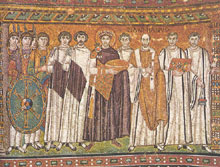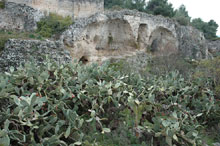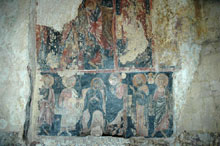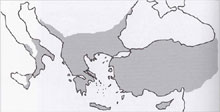 |
| Mosaic from San Vitali in Ravenna, at the time
when Byzantine art blossomed. Justinian is in the center and
the archbishop of Ravenna, Maximian, is on his left. |
With the collapse of the Roman Empire, in the 5th century A.D., the region
of South Italy suffered from the invasions of northern barbarian tribes.
At the end of that century, the Byzantines, after the founding of Constantinople
(Istanbul) in 330 A.D. and the division of the Roman Empire, had regrouped
politically and militarily and returned to Italy seeking to recover the
territories they had lost.
In the middle of the 6th century, in 551A.D.,
Justinian made old Narses (who was at the time 70 years old) Commander
in Chief, responsible for the extermination of the Goths that infested
Italy. After repeated battles, Goths lost in October of 552, in the region
of Pompei; their scattered garrisons lasted until 562 A.D., when the whole
of Italy found itself under the power of the Byzantines. At the time of
Justinian’s death in 565, the Byzantine Empire extended to the Herculian
Pillars of Gibraltar and up to the fringes of Caucasus.
A new threat has however emerged in the region of Italy, the Longobards
who lived in the northeast. The Longobards progressively conquered
big regions of Italy limiting the Byzantines in isolated sections of
power around Genoa, Ravenna, Naples, Apulia and Calabria.
During the reign of Leo the 3rd in 726 B.C., the period of the Iconoclasts
began in Byzantium (726-843 A.D.), which caused the division of the
Byzantine society and the intense conflicts between iconomachs (iconoclasts)
and idolaters. The conflict, which almost became a civil war, forced
thousands of monks, called Basilians to migrate from Syria and Cappadocia
and to settle in South Italy, giving a new boost to the Greek character
of the region. The Basilian monks as well as the priests with their
families settled in the south of Italy, often in caves carved out on
the rocks, copying their way of life from Cappadocia and Syria, while,
at the same time, they revived the Orthodox church and its rituals.
 |
 |
| Caves carved in the rock, where Basilian monks lived in Massafra... |
...and Matera. In many of these hermitages, some frescoes remain, quite preserved to this day. |
| |
In the turbulent years that followed, the threat of the Arabs and the
Saracenes also appeared; in the 9th century they managed to conquer
Sicily and South Italy reaching up to the regions of Campania and Apulia,
while at the same time, the other claimants of the region were the
Francs. From the 10th century onwards, the threat of the Arabs compelled
the conquerors of Italy to accept the dominion of Byzantium, the sole
major power of the era. After a failed effort of the Byzantines to
take over Sicily from the Arabs in 965- it was only in 1006 that the
Byzantines defeated the Arabic fleet- confining the Arabs to Sicily.
 |
| The Byzantine empire during the reign of Vasileios
B´ (976-1025 A.D.) a few years before its final withdrawal from
South Italy which was conquered by the Normans in 1071 A.D. |
Three years later, in 1009, during the reign of Vasileios B’ Voulgaroktonos
(976-1025 A.D.) the Byzantines faced the revolt of the sovereign Melo
of Bari, who sought the aid of the Normands. In a blooded battle in
Canosa, the Normans lost and the Byzantines restored South Italy under
the Byzantine sovereignty.
The sovereignty of the Byzantines was however short-lived and progressively
until 1071, when the Normans occupied Bari, the Byzantine sovereignty
in Italy was finally disrupted.
From the Byzantine era only few cultural influences survive to this
day, most of which are religious (churches and hermitages carved
in the rocks,
icons preserved in monasteries etc.). The best-preserved caves carved in
the rocks, are to be found in the regions of Massafra and Mottola, north
of Taranto.